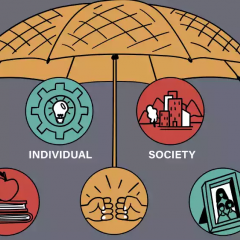Executive summary
This report sets out the findings of research into women’s online involvement in far-right extremism analysed through the lens of the Good Lives Model (GLM). It addresses the lack of research on the gendered nature of the needs that are being met when engaging in such spaces.
The findings are based on an analysis of a women only right-wing forum hosted by Stormfront, the oldest white nationalist online community. The results highlight which goods are pursued, what needs are met, and how norms around goods are constructed.
A range of goods were identified as important and were achieved in different ways.
- Healthy living is usually fulfilled through the creation of a white family and raising children according to white nationalist ideology.
- Community is found on Stormfront and sustained through a cluster of primary goods including play, pleasure, and relatedness.
- Ways of meeting the good of creativity include cultivating one’s appearance in a way that indicates support for their ideology.
- Agency is found through a variety of roles; usually that of the stay-at-home mother or as a promoter of white nationalist ideology, either online or offline.
- Stormfront women appear to seek knowledge and work due to a desire to serve the movement better. They also advocate for a 'softer' expression of their beliefs, that distances them from violence, principally to facilitate recruitment.
By testing the applicability of the GLM to an online platform, this research affords a better understanding of the opportunities provided by online extreme communities to fulfil women's needs. It demonstrates the utility of the GLM and its ability to help interpret the goods women attain through involvement in extremist spaces.
Understanding the goods and needs that online spaces fulfil has the potential to inform gender-responsive programmes to Prevent and Counter Violent Extremism (P/CVE). By highlighting the gendered nature of goods, the analysis illustrates that ‘gender blind’ programmes are unlikely to address the particular needs of women.
A GLM-informed analysis has the potential to inform P/CVE interventions by identifying the goods that might be relevant to certain communities, and the women who make them up, and using that understanding to identify interventions that make opportunities to achieve those goods in pro-social, positive ways more accessible.
This CREST report is informed by a review of research on protective factors set out in an earlier report. You can find all the outputs from this project here.
The research for the report was supported by the Center for Research on Extremism (C-REX). C-REX is a cross-disciplinary centre for the study of right-wing extremism, hate crime and political violence at the University of Oslo, and the Handa Centre for the Study of Terrorism and Political Violence at the University of St Andrews.
Read more
Agius, C., Edney-Browne, A., Nicholas, L., & Cook, K. (2022). Anti-feminism, gender and the far-right gap in C/PVE measures. Critical Studies on Terrorism, 15(3), 681–705. https://doi.org/10.1080/17539153.2021.1967299
Amarasingam, A. (forthcoming). Belonging is Just a Click Away: Extremism, Radicalization, and the Role of Online Communities. In Busher, J., Malkki, L. and Marsden, S.V. The Routledge Handbook of Radicalisation and Counter-Radicalisation. Routledge
Broidy, L., & Agnew, R. (1997). Gender and crime: A general strain theory perspective. Journal of Research in Crime and Delinquency, 34(3), 275–306. http://dx.doi.org/10. 1177/0022427897034003001
Campion, K. (2020). Women in the extreme and radical right: Forms of participation and their implications. Social Sciences, 9(9), 149. https://doi.org/10.3390/socsci9090149
Lee, B. (2022). Lethal Subcultures. Centre for Research and Evidence on Security Threats.
Leidig, E. (2023). The Women of the Far Right. Columbia University Press.
Molas, B. (2023, July 3). Falling through the cracks: Gender bias in online counter-terrorism and prevention. Global Network on Extremism and Technology. https://gnet-research.org/2023/07/03/falling-through-the-cracks-gender-biasin-online-counter-terrorism-and-prevention/
Paalgard Munden, H., Marsden, S.V., Kamruzzaman, Md., Rahlf, L., Rigault Arkhis, H., and Taylor, A. (2023). Can involvement in violent extremist groups be understood as an effort to attain primary goods?. Centre for Research and Evidence on Security Threats
Pflugradt, D. M., & Allen, B. P. (2019). The application of the good lives model to women who commit sexual offenses. Current Psychiatry Reports, 21(12). https://doi.org/10.1007/s11920-019- 1115-z 6356
Samuels, S., & Shajkovci, A. (2023). Far-right violent extremist women: Threats and security considerations. Women & Criminal Justice, 33(3), 221–240. https://doi.org/10.1080/08974454.2022.2040696
Van Damme, L., Fortune, C.-A., Vandevelde, S., & Vanderplasschen, W. (2017). The good lives model among detained female adolescents. Aggression and Violent Behavior, 37, 179–189. https://doi.org/10.1016/j.avb.2017.10.002
Veilleux-Lepage, Y., Phelan, A., & Lokmanoglu, A. D. (2022). Gendered radicalisation and ‘everyday practices’: An analysis of extreme right and Islamic state women-only forums. European Journal of International Security, 8(2), 227–242. https://doi.org/10.1017/eis.2022.32
Windisch, B. (2021). A downward spiral: The role of hegemonic masculinity in lone actor terrorism. Studies in Conflict
Copyright Information
As part of CREST’s commitment to open access research, this text is available under a Creative Commons BY-NC-SA 4.0 licence. Please refer to our Copyright page for full details.
IMAGE CREDITS: Copyright ©2024 R. Stevens / CREST (CC BY-SA 4.0)






